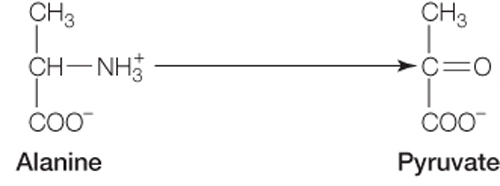Apply What You’ve Learned
Review
9.5 The synthesis and breakdown of macromolecules in a cell are linked through common metabolic pathways.
9.5 Metabolic pathways are regulated to ensure efficiency and proper functioning of the cell.
Original Papers: Cahill, Jr., G. F. 2006. Fuel metabolism in starvation. Annual Review of Nutrition 26: 1–
Exton, J. H. and C. R. Park. 1967. Control of gluconeogenesis in liver: I. General features of gluconeogenesis in the perfused livers of rats. Journal of Biological Chemistry 242: 2622–
People desperate to lose weight quickly sometimes resort to crash diets, which involve severely limiting foods rich in energy. But how effective is this strategy? What happens to the body when it is starved of food? Scientists have studied starvation in mammals to find out how their bodies compensate for a lack of food. Their findings can be used to better understand the effects of severe diets on the human body.
Studies have shown that mammalian bodies need a constant supply of glucose to maintain homeostasis. Food provides a regular supply of glucose, and when there is an excess, the body stores it as glycogen. Figure A shows how cells in the human body shift in their rate of glucose oxidation and the source of glucose oxidized after food intake has stopped.
Figure A

192
These data indicate that once glycogen reserves are used up, the body uses other molecules as sources of glucose. What are these molecules? To find out, researchers studied the biochemistry of the liver, since it is the major organ where glucose is made (gluconeogenesis). They surgically removed livers from healthy rats and kept the livers in an active physiological state using perfusion. Perfusion is a technique that pumps fluids through the blood vessels of an organ to mimic the normal blood flow taking place inside a living animal. Using perfused rat livers, the researchers tested the production of glucose inside liver cells when various metabolic compounds were pumped through the isolated livers. They did this by measuring glucose concentration (mM) in the perfusion fluid leaving the livers. The results of their studies are shown in Figure B and the table. (The data in Figure B were gathered from the livers of fasted rats.)
Figure B

| Experiment number | Condition | Additions | Rate of glucose production through gluconeogenesis (μmoles/g liver/hr) |
|---|---|---|---|
| 1 | Fasted rats | Protein | 55.0 |
| 2 | Fasted rats | Fatty acid + protein | 58.9 |
| 3 | Fed rats | No addition | 105.4 |
| 4 | Fed rats | Fatty acid | 99.0 |
Questions
Question 1
According to data in Figure A, what does the human body do to supply glucose to its organs once food intake stops?
The body first uses glucose supplied from the last meal, then begins to break down glycogen. Once all of the glycogen is gone, the body makes glucose through gluconeogenesis using molecules present in the body.
Question 2
Most people want to lose fat when they diet. Ideally, these people would like their fat to be used as fuel when they restrict their food intake. Recall that triglycerides are one form of fat stored in the body, and that a triglyceride is composed of a glycerol molecule bonded to three fatty acid molecules. Also recall that proteins are composed of amino acids. Assuming that all mammals respond as rats do, what do the data from the rat perfusion studies suggest about the identities of the molecules that mammalian bodies use to make glucose under starvation conditions?
Mammals break down proteins and use amino acids to make glucose through gluconeogenesis. Mammals also use glycerol from triglycerides, but they do not use fatty acids in this way. Fatty acids do not stimulate gluconeogenesis.
Question 3
Considering your answer to Question 2, and assuming that all mammals respond as rats do, what is likely to happen to the muscles of a person who goes on an extreme calorie-
The person will lose muscle mass because proteins in muscle cells will be broken down to make glucose via gluconeogenesis. This is not advisable because this will weaken the person’s body and put him or her in a state of low body fitness. People generally do not realize this because they think that dieting will cause loss of fat rather than muscle.
Question 4
Alanine is an amino acid that has been shown to be an important intermediate in the gluconeogenesis pathway. Find and compare the structures of alanine and pyruvate. Show how an atom in an alanine molecule could be radiolabeled so that it could be traced through the formation of pyruvate as part of the gluconeogenesis pathway.
Any of the carbon atoms in alanine could be labeled with carbon-
